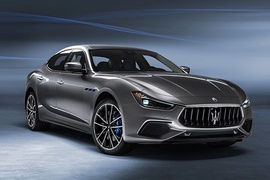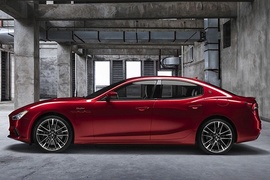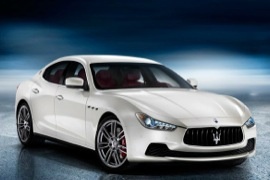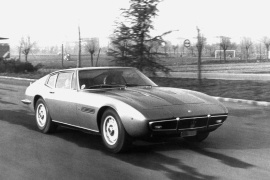
MASERATI Ghibli
Generations Timeline, Specs and Pictures

The Maserati Ghibli’s electrification marked a new beginning for the Italian brand, offering a powerful, yet ecological, version for its smallest four-door sedan.
The four-door Maserati Ghibli was unveiled at the 2013 Shanghai Motor Show, and it was upgraded continuously both in terms of aesthetic and performance factors. In its quest to lower the emissions, Maserati dared to offer it with a turbodiesel engine as well. In 2020 it started to sell the Ghibli with a mild-hybrid powertrain that promised to increase its fuel-efficiency.
The hybrid version of the Ghibli was visually different when compared to its brothers. The main ingredient was the light blue color that enhanced the side vents on the front fenders, the brake calipers, and the oval that enclosed the Trident on the C-pillar. The grille featured a different design with ten slats but curved as a trident fork (an instrument for tuning acoustic instruments).
Inside, the Ghibli Hybrid was fitted with the best amenities available in the Maserati storage. The instrument cluster featured a TFT color display between the speedometer and the tachometer. The infotainment system featured a big touch-screen on the center stack. The interior door panels featured blue stitches, but the car’s sporty character was not left aside, and carbon-fiber trims were installed on the center console.
The powertrain consisted of a twin-turbo 2.0-liter engine and an electric motor. It was mated to an 8-speed automatic transmission.

The Maserati Ghibli was upgraded in August 2020 with a twin-turbo Ferrari engine, that brought more grunt to the smaller Italian sedan.
Maserati was in constant evolution in 2020, despite the hard times caused by the world pandemic situation. It launched new models, such as the MC20 supercar, and a more powerful version for its four-door models. The Ghibli was the entry model for the four-door lineup. It was built for the customers who were looking for a supercar dressed as a regular, four-door, sedan.
From the outside, the Trofeo looked similar to the regular Ghibli, but some details made a difference. At the front, the car featured a different bumper and apron design, with a wider center grille and modified side-scoops to cool the brakes. The hood was modified and featured a pair of vents, to help to cool the engine. From the side, the front fenders featured three vents with red trims and the Trofeo badge. On the C-pillars, under the brand’s badge, a red stripe was installed.
Inside, the Trofeo was fitted with the best amenities available in the Maserati storage. The instrument cluster featured a TFT color display between the speedometer and the tachometer. The infotainment system was fitted with a big touch-screen on the center stack. To complete the sporty character of the car, carbon-fiber trims were installed on the dashboard and the center console.
It was the first time when a V8 found its way into the Ghibli range. A 3.8-liter engine was placed under the hood and paired to an 8-speed automatic transmission. Power went to the rear wheels only, via a standard limited-slip differential. For better control of the 580 hp, the Ghibli Trofeo was fitted with an Integrated Vehicle Control (IVC) system, tuned for enhanced vehicle dynamics, and better active safety.

The name wasn’t new, but it was the first Ghibli to be offered as a four-door vehicle, which the Italians said it was a four-door coupe.
The 2017 model was a refreshed version of the 2013 model.
With the increasing market for the sports sedan vehicles, Maserati took the Ghibli name from its warehouse and installed it on a brand new vehicle. It used the same platform as the Quattroporte and the Levante SUV. The refreshed version added more power and, of course, an Euro 6 homologation certificate.
The exterior design remained the same as before, but the car-maker introduced two trim levels: Luxury and Sport. With its sporty, coupe-like, look, the Ghibli was the shorter version of the brand’s flagship, the Quattroporte. The headlights converged toward the Trident, with every angle designed to draw the attention to Maserati’s legendary symbol.
Inside, the Ghibli received a new dashboard and a brand new 8.4” infotainment system, which was Android Auto and Apple CarPlay compatible. The instrument cluster featured large analog dials dor the speedometer and tachometer, plus a 7” TFT display. On the latter, major dynamic functions were incorporated into the buttons next to the gear-stick, while other on-board settings could have been set via the Maserati Touch Control Plus rotary knob placed in the center of the dashboard. The 7” TFT display was accessed via the steering wheel buttons.
Under the hood, the Ghibli received a new update for its engines. The gasoline units were produced by Ferrari, its parent company, while the diesel version was offered by Fiat Power Train (FPT). Standard transmission was an 8-speed automatic. The top-model, named SQ4, was offered with an all-wheel-drive system.

Maserati introduced the facelifted version of the Ghibli at the Chengdu Motorshow in China and introduced a luxurious trim level named GranLusso.
With an increased demand for sport-sedans, the Chinese market was ideal for the Italian carmaker Maserati to unveil the facelifted version of the Ghibli. It shared its platform with the Quattroporte and the Levante SUV. The mid-size premium sedan promised a sporty experience, even though it was not available with a V-8 under the hood. But worth mentioning that, unlike other Italian brands, it was engineered by Ferrari.
The Ghibli GranLusso sported the same design language as its bigger brother Quattroporte. A pair of boomerang-style headlights with Matrix-LED adorned the front fascia. Between them, but lower, a grille with vertical slats sported the trident badge of the carmaker. From its sides, the flowing lines raised up above the rear wheel-arches. In the rear apron, Maserati installed a quad-exhaust system. Besides all the sport-inspired elements, the Ghibli tried to be the decent sport-luxury sedan. Sort of an upgrade from a Mercedes-AMG C-Class.
Inside, the Italian carmaker created a luxurious and high-tech interior. The Ghiblis’ front sport bucket seats were both elegant and supportive. A big infotainment touch-screen took more than half of the center stack, while a tall and wide center console separated the front seats. In the back, Maserati created a bench profiled for two passengers.
Under the hood, Ferrari installed a choice of two turbocharged V-6 engines. Both were paired with an eight-speed automatic gearbox. Power went to the rear or to all four wheels.

Maserati revived the Ghibli name in 2013 for the smaller brother of the Quattroporte flagship model and aimed at the sports sedan market.
After fifteen years since the Ghibli nameplate was dropped from the market, Maserati decided to revive it. Unlike its predecessor, which was built between 1992 and 1998, the 2013 model was a four-door sedan, not a coupe. But, most importantly, it was the first Maserati available with a turbo-diesel engine.
The 2013 Ghibli shared the same platform with the Quattroporte and was 291 mm (11.5”) shorter than its bigger brother. At the front, it featured a front fascia with a low-mounted grille with twelve vertical slats and the trident-badge in the middle. The boomerang-style headlights sported the daytime running lights and, on the lower side of the bumper, the carmaker placed a broad grille extended from side to side. The Ghibli showed a muscular profile, with a firm shoulder over the rear wheel arches.
For the interior, the Italian carmaker took care of it to make its cabin feel friendly and luxurious. The keyless system was on the options list, and so was the new infotainment unit installed on the center stack. Despite the dashboard’s minimalist design, with just a few buttons on the center stack, the Ghibli showed a luxurious look. Its front bucket seats with higher bolstering than a regular sedan provided better side support during high-speed cornering. In the back, the carmaker installed a bench profiled for two passengers.
Under the hood, Maserati installed a choice of two V-6 engines. Despite having the all-wheel-drive system available for the gasoline-powered version, it wasn’t available for the diesel-powered one.

As Lamborghini offered the Miura and Ferrari the 365 GTB, Maserati responded with the Ghibli back in 1967.
Compared to the Miura, the purpose of Maserati was not to offer the fastest car, but a fast car people could travel in luxury. The Ghibli was rather a refined GT than a pure sports car.
The Ghibli was the most expensive of the 3, however, it managed to outsold the Ferrari and Lamborghini.
One of the most GT ever built, the Ghibli was designed by Giugiaro, the same person who designed the De Tomaso Mangusta and the BMW M1. Giurgiaro was the best designer of the 20th century.
One word would have defined the interior of the Ghibli, and that was “leather”. Everything was covered high quality soft leather to maintain the luxury.
The dashboard was extremely simply and stunning at the same time. On of the biggest assets of the Ghibli was the cargo space. The beautiful vehicle offered an enormous trunk and that made it a great daily car, as well as a perfect companion for long trips.
The fast car was powered with a 4.7-liters V8 engine equipped with 4 Weber carburettors. The powerplant developed 330 hp and the redline was reached at 5500 rpm. The powerplant was rather a detuned version of a race car’s engine.
The Ghibli was very easy to use, having a very smooth clutch, as well as a smooth gearbox.























































